Bafia people
The Bafia (Baepak) people inhabit the Mbam region in the Centre Region of Cameroon. Their origins are said to be similar with those of the Bamun and Tikar people. A division during migratory movements caused the two sets of groups to settle in different areas. Later, the Islamisation of most of the Bamun territory further separated them. A yearly festival held in Fumban (Bamun territory) is considered by many to symbolize the recognition of their common heritage.
Baepak | |
|---|---|
 Danse Bafia | |
| Total population | |
| 127,000[1] | |
| Regions with significant populations | |
| Centre Region (Cameroon) | |
| Languages | |
| Bafia | |
| Religion | |
| Catholicism | |
| Related ethnic groups | |
| Bamun, Tikar |
Their language is Bafia.
Names
A Bafia father will give his child a personal name to which his own name (patronyme) is appended. For instance, a father named "Keman a Ndiomo" may call his son "Bitegni a Keman". The "a" in the middle stands for "son of".
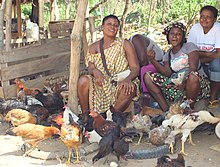
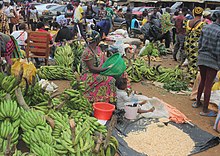
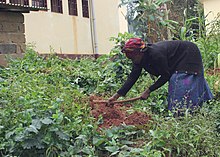





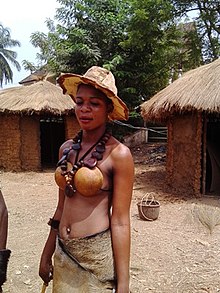
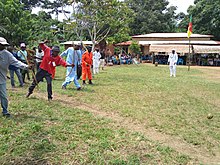
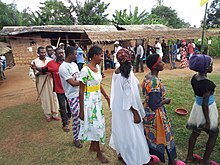


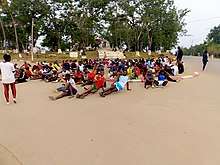
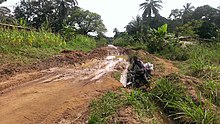
Dance
The traditional dance of the Bafia is seen to convey a sense of heightened excitement and joy through posture and facial expressions. Dances are traditionally held after successful harvests, although they may also be performed during engagements, weddings, and other official events.
Religion
The earliest recorded religious tradition amongst the Bafia was that everything in the world developed from an egg. Both feminine sexual forces, represented by a cave or hollow tree, and masculine sexual forces, represented by a snake or vine, were involved. There was no afterlife, God, nor sin.[2]
The turtle is respected as a traditional totem animal. There is an age-old belief that turtle shells are sacred and can be used to resolve disputes within the community. All those involved are required to lay their hands on the animal's shell as a way of eliciting the truth. The hands of the guilty party will then supposedly contract leprosy as punishment for evil deeds.
Today, the dominant religion is Protestant Christianity ("Mareucana" is the Bafia term), although a small section of the population has converted to Islam (for which the Bafia term is "Moussouloumi").
Sexuality
Traditional life amongst the Bafia, as recorded by Günther Tessmann in 1921, encouraged "conspicuous and significant, naïveté and freedom in sexual activity".[3] Childbirth was joyfully explained to children as soon as they could speak, and sexual play was condoned by age five or six. Until puberty both boys and girls were given free rein to engage in sexual play, but this was not considered genuine sexuality, and children emerged at puberty still considered virgins.
At menstruation, young women were strictly segregated to avoid unplanned pregnancies; at this stage, they were known as "ngon", or sexually inactive virgins. Young men usually engaged solely in homosexuality during this stage and were known as "kiembe", youths who don't yet sexually associate with females. Many young men would develop a boyfriend type of relationship with a special lexan or "bosom buddy". A man who attempted sex with a woman of the "ngon" stage could face torture or even being sold into slavery. He was free to pursue a fully adult woman, but Tessmann stated that, "the youth at this stage is rarely successful, since there is much competition."[4]
Upon reaching full adulthood, most men would attempt to abduct a woman for sex. Frequently lexan would team up to find female partners, and might even share a woman in a ménage à trois. Tessmann theorized that "those who formerly engaged only in homosexual intercourse, aroused by the sight of their comrades, are thereby won over to heterosexual relations."[5] At this stage, men were known as "ntu", boys without children who have sexual relations with females, and women as "tsobo", women without children.
After pregnancy & childbirth, men became known as "mbäng", men who have children, and women as "gib", women with children. A father would customarily give a child the name of his former lexan or "busom buddy", regardless of gender. Tessmann was intrigued that due to this custom "a delicate lass runs about with a formidable male name like 'Buffalo' or 'Man of Death.'"[6] He also noted that a few men would remain permanently homosexual through adulthood, although he never met any himself.
List of Bafia dishes
Bafia people, like many other ethnic groups in Cameroon, are mainly vegetarians.
- Bitosso (generally eaten with some sort of Maize pudding known locally as kipen (kipain))
- Kidjan (Kidjan ki Tchen)
- Gbarak (sticky saucy made with Okra and bush meat)
- Koum-koum
- Tien ti meukaaba
- Tien ti nguita (sweet potato leaves)
- Bichongneu
- Zaap (bita leaves)
- Bieeloe
- Mouleuk (for seasoning)
List of Bafia villages
- Bapep
- Biabiyakan
- Sanam
- Biamesse
- Biamo
- Bitang
- Dang
- Donenkeng
- Goufan
- Gouife
- Isèri
- Kiki
- Koro
- Lablé
- Mouko
- Nyamsong
- Nyokon
- Roum
- Rimis
- Rionon
- Tchekani
- Yakan
References
- "Bafia, Baepak in Cameroon". Joshua Project. Retrieved 5 May 2019.
- Boy-Wives and Female Husbands: Studies of African Homosexualities, edited by Stephen Murray & Will Roscoe. Published by St. Martin's Press in 1998. pp. 150- 151
- Boy-Wives and Female Husbands: Studies of African Homosexualities, edited by Stephen Murray & Will Roscoe. Published by St. Martin's Press in 1998. p. 151
- Boy-Wives and Female Husbands: Studies of African Homosexualities, edited by Stephen Murray & Will Roscoe. Published by St. Martin's Press in 1998. p. 153
- Boy-Wives and Female Husbands: Studies of African Homosexualities, edited by Stephen Murray & Will Roscoe. Published by St. Martin's Press in 1998. p. 154
- Boy-Wives and Female Husbands: Studies of African Homosexualities, edited by Stephen Murray & Will Roscoe. Published by St. Martin's Press in 1998. p. 154